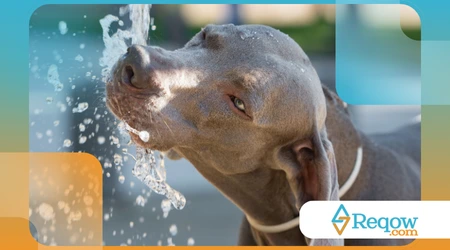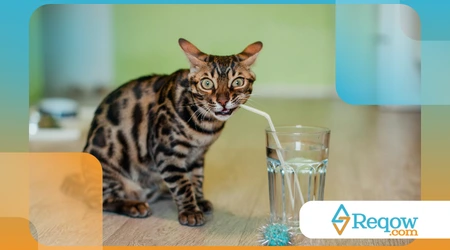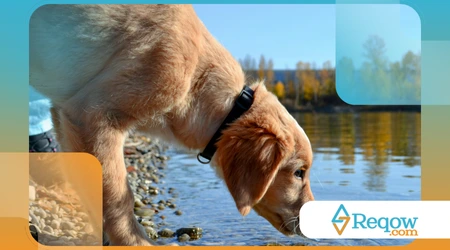Pets drinking too much water: normal behavior or red flag?

Pets that drink too much water. Hydration is vital for all living beings, and our pets are no exception. Water plays a crucial role in organic functions.
Advertisements
It regulates body temperature, transports nutrients, and eliminates toxins from the body. Maintaining water balance is essential for health.
But what happens when thirst seems unquenchable? When the water fountain is always empty?
More Than Thirst: Unraveling Canine and Feline Polydipsia
The technical term for excessive water consumption is polydipsiaIt's not just about drinking more than usual.
It's a significant and persistent increase in fluid intake. Understanding its causes is crucial for animal welfare.
Advertisements
Polydipsia can be primary, when the animal actually feels more thirsty. Or it can be secondary, resulting from other conditions.
When Thirst Is Normal: Understanding the Context
Not all excessive thirst is cause for alarm. Context is crucial to interpretation.
Hot days, intense exercise, or high-sodium diets increase your water needs. This is perfectly normal and expected.
Animals that consume dry food tend to drink more water than those that eat wet food. Diet directly influences hydration.
Specific medications can also increase thirst. Always check the label and talk to your veterinarian.
Yellow Signal: Common Causes of Worrying Polydipsia
However, polydipsia can indicate underlying health problems. Ignoring these signs can be harmful.
Kidney disease is often associated with increased thirst. The kidneys lose their ability to concentrate urine.
This causes the body to try to compensate for the excessive fluid loss, causing the animal to drink more to stay hydrated.
Diabetes mellitus is also a common cause of polydipsia. The body cannot use glucose properly.
++ How to identify pain in pets that don't show visible symptoms
Excess glucose is eliminated through urine, bringing more water with it. This creates the need to drink more.
Hyperadrenocorticism, or Cushing's syndrome, is another condition that involves excess cortisol in the body.
This syndrome affects fluid and electrolyte balance, leading to increased water intake.
Pyometra, a uterine infection in intact females, also causes polydipsia. It is a serious veterinary emergency.
Liver disease can alter water metabolism, leading to unusual thirst.

The Case of Mia, the Thirsty Persian
Mia, an 8-year-old Persian cat, started drinking water nonstop. Her owner noticed that the bowl was drying out quickly.
In addition to excessive thirst, Mia was urinating profusely and losing weight. These were clear signs.
After testing, the diagnosis was diabetes mellitus. Appropriate treatment controlled the thirst and other symptoms.
Mia now leads a full and healthy life, with balanced hydration. Early diagnosis was crucial.
Marley the Labrador and His Unexpected Increase in Thirst
Marley, an active 6-year-old Labrador, had always been a regular drinker. Suddenly, he started emptying his water bowl several times a day.
His owners noticed he was also urinating more frequently. A visit to the vet was essential.
Read more: 5 attitudes that affect your pet's emotions and how to avoid them
Blood and urine tests revealed early-stage kidney failure. Early treatment was initiated.
Marley's quality of life was preserved, and the polydipsia was controlled. Veterinary monitoring is vital.
The Impact of Age and Race on Water Intake
Your pet's age influences their water needs. Puppies and seniors may have different needs.
Growing puppies need plenty of hydration. Older dogs can experience kidney dysfunction.
Some breeds are more predisposed to certain diseases. For example, Labradors are more susceptible to diabetes.
The Importance of Early Diagnosis: Why Act Fast?
The analogy to a fire is pertinent here. A small fire can be easily contained.
If neglected, it can spread and become a major disaster. The same goes for your pet's health.
Early detection of any changes is crucial. This allows for more effective and less invasive treatment.
Ignoring warning signs can lead to serious and irreversible complications. Prevention is always the best option.

The Path to Diagnosis: Essential Tests
If you notice your pets that drink too much water, seek veterinary care immediately. The professional will perform a thorough evaluation.
A medical history and physical examination are the first steps. The veterinarian will also look for other symptoms.
Blood tests, such as complete blood count and biochemistry profiles, are essential. They assess kidney and liver function.
Look how interesting: Pets and Vet Visits: How to Prepare Your Pet and Reduce Stress
Urinalysis is crucial for checking the density and presence of glucose. It also screens for infections and crystals.
In some cases, imaging tests such as ultrasound may be necessary. They can reveal changes in internal organs.
| Parameter | Normal Level in Dogs | Normal Level in Cats | Possible Condition in Case of Change |
| Blood glucose (mg/dL) | 70-120 | 70-150 | Diabetes Mellitus |
| Creatinine (mg/dL) | 0.5-1.5 | 0.8-1.8 | Kidney Disease |
| Urea (mg/dL) | 10-50 | 15-60 | Kidney Disease |
| Urinary Density | 1.015-1.045 | 1.020-1.040 | Diabetes Insipidus, Kidney Disease |
Source: Based on common reference values in veterinary laboratories. Always consult a veterinarian to interpret results.
Prevention and Management: Maintaining Adequate Hydration
Keeping the water fountain clean and stocked with fresh water is essential. Hygiene encourages drinking.
Provide more than one water source if possible. Some pets prefer to drink from specific locations.
Moving water sources can encourage drinking. Many animals are attracted to the coolness.
Consider adding a little water to dry food, if your pet will accept it. This increases water intake.
Monitor how much water your pet drinks daily. Keeping a record can be helpful.
Observe changes in urination patterns and general behavior. Any changes warrant attention.
Polydipsia and Chronic Diseases
A study published in the Journal of the American Veterinary Medical Association (JAVMA) in 2023 revealed that approximately 201,000 dogs over 7 years of age had polydipsia at some point.
Of these, most were diagnosed with chronic kidney disease or diabetes mellitus. This highlights the importance of monitoring older animals.
Paying Attention to the Signs, Promoting Well-Being
Monitor the water consumption of our pets that drink too much water It's an act of care and responsibility. It's a vital indicator of your health.
Not all excessive thirst is serious, but ignoring it can have serious consequences. Proactive action saves lives.
A partnership with a trusted veterinarian is irreplaceable. They are your guide to your pet's well-being.
Is your pet showing any worrying signs? Act now and ensure your pet lives a long and healthy life.
Frequently Asked Questions
1. What is the normal amount of water a pet should drink per day?
The amount varies greatly depending on size, species, activity level, and diet. On average, dogs and cats should drink about 50 to 100 ml of water per kilogram of body weight per day.
2. Can I offer other liquids, such as milk or juice, to my pet?
Not recommended. Fresh, clean water is always the best option. Milk can cause intolerance and digestive problems. Juices are high in sugar and are not suitable for pets.
3. How can I encourage my pet to drink more water?
Provide fresh, clean water in various locations throughout the home. Use ceramic or stainless steel water fountains, which keep the water cooler.
Consider pet water fountains, which keep the water moving and stimulate curiosity.
4. My pet drank a lot of water after a walk. Is this normal?
Yes, it's completely normal. After exercise or on hot days, pets lose more fluids and need to rehydrate. Observe whether excessive thirst persists even when resting.
5. If my pet drinks a lot of water, does that mean he has diabetes?
Not necessarily. Although diabetes is a common cause of polydipsia, other conditions such as kidney or liver disease, or even the use of certain medications, can also cause it. Only a veterinarian can provide an accurate diagnosis.
6. My pet drinks more water than usual, but seems healthy. Should I be concerned?
Yes, any significant change in behavior, including increased water intake, should be investigated by a veterinarian.
Many diseases can be asymptomatic in their early stages, and polydipsia can be one of the first signs. Early detection is crucial.
